Creating online courses and other digital content is becoming one of the best ways to monetize your blog or add a passive income stream to your business. Teachable is one option, but there are other great Teachable alternatives available.
There are course platforms that offer all-in-one systems, including native email marketing applications. There are others that are simply course marketplaces to sell your content.
We’ve taken a close look at all of the Teachable alternatives out there to give you the best options for your courses, including:
7 of the Best Teachable Alternatives for 2020
1. Kajabi
Kajabi is an all-in-one online course platform that has tools for creating courses, marketing, blogging, and email automation. The idea behind Kajabi is that you get everything you need to create, market, launch, and teach your classes.
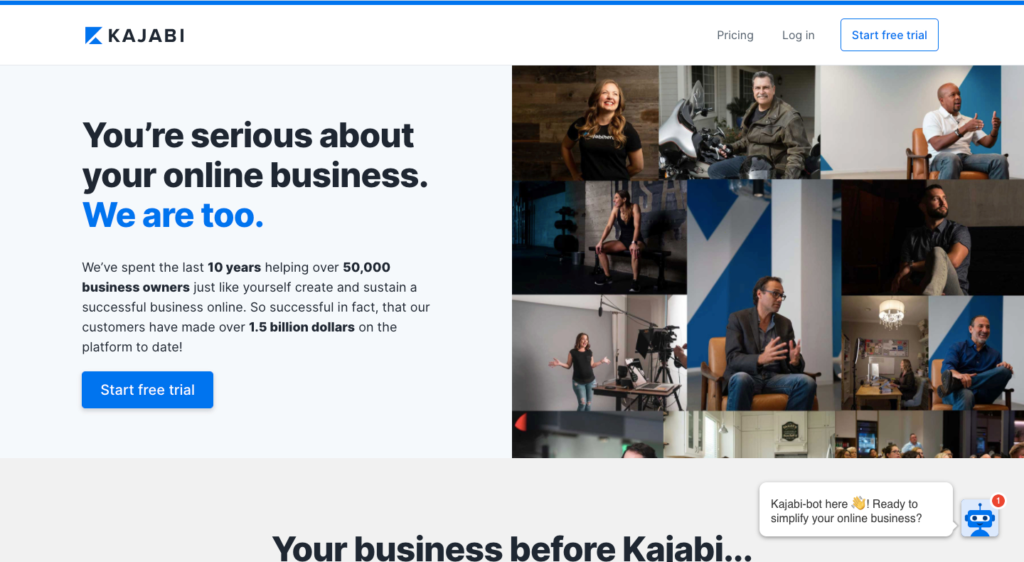
Kajabi Pipelines are one of the most well-known features, and these are templates for automated marketing and sales funnels. There are different Pipelines built for specific kinds of product launches, like webinars, ebooks, courses, etc.
Here’s an example of a Kajabi pipeline for a Zoom webinar. Below is a list of all the components it includes, and you’re just responsible for writing your own copy, images, and branding:
- Webinar registration page
- Confirmation page
- 4 emails leading up to the webinar
- 5 emails after the webinar
- Linked sales page
- Checkout page to finalize purchases
Using Pipelines is completely optional — you can create email sequences and landing pages without it.
Kajabi also has analytics tools, a drag-and-drop editor, Kajajb University (educational content), unlimited video hosting, an integrated checkout, list building tools, Zapier integrations, built in SEO optimization, affiliate program capabilities, and auto scaling technology.
The courses you create on Kajabi can come with payment plans, coupons, drip content, quizzes, and course insights to see how students are progressing through the course. You can also add one-click upsells and subscription-based membership sites.
Kajabi pricing
Out of all of the Teachable alternatives on this list, Kajabi is by far the most comprehensive option, but it’s also the most expensive. The lowest-priced plan is $119/month when you bill annually, and the price goes up based on the number of products, contracts, and active members you have in the course.
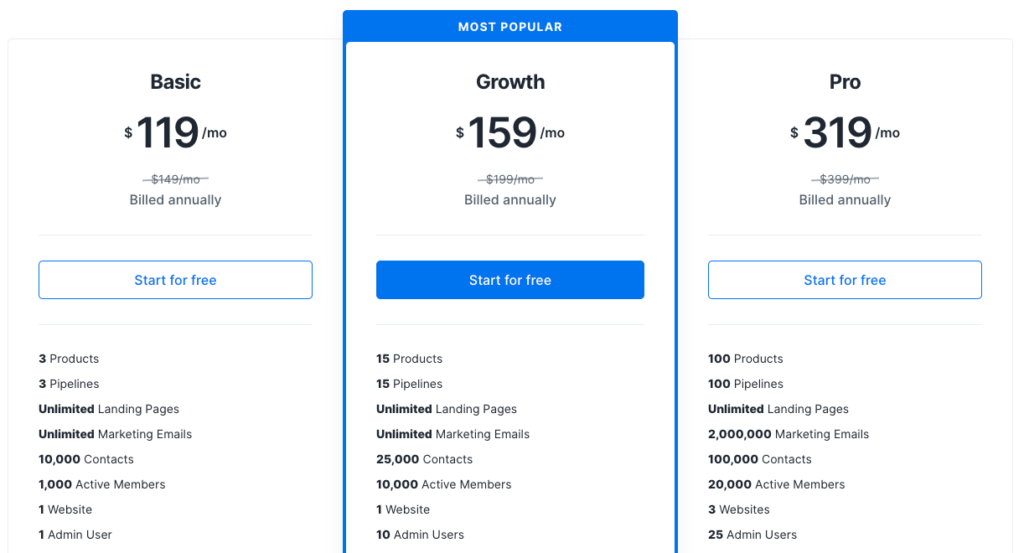
Kajabi pros and cons
Pros:
- It’s a complete business solution
- Has email automation tools
- Kajabi Pipelines are a solid marketing solution for beginners who aren’t sure how to organize sales pages, emails, and registration pages in a way that drives sales
Cons:
- Dependent on one system
- More expensive without a free trial
- There’s no open course marketplace for customers to browse
2. Thinkific
Thinkific has a powerful online course builder that gives you options for creating self-directed, hybrid, and group classes. It has tools for creating multimedia-rich courses, and you can also host membership-based sites with Thinkific.

Users create a Thinkific school — this is the website where all of your courses are hosted — and your school can have additional pages for FAQs and an about section.
Your courses can include videos, PDFs, voice-over Powerpoint presentations, downloadable content, student discussions, quizzes, surveys, and text. You can even create private and hidden courses, prerequisite lessons, and have multiple teachers.
To help you sell your courses, you can offer coupons and bundle your courses. There’s also the option to set up an affiliate program for your courses on Thinkific.
Thinkific also has tons of Zapier integrations so you can connect software you’re already using, like an email service provider. There’s also analytics and ad tracking for Google Words and Facebook ads.
Thinkific pricing
There is a free option with Thinkififc, but it has a pretty limited list of features — it’s really meant to test out the software. You will need to pay for a plan (lowest price is $39/month when you pay annually) to access features like:
- Zapier integrations
- Drip content
- Email integrations
- Manual student enrollment and exports
- Custom domain
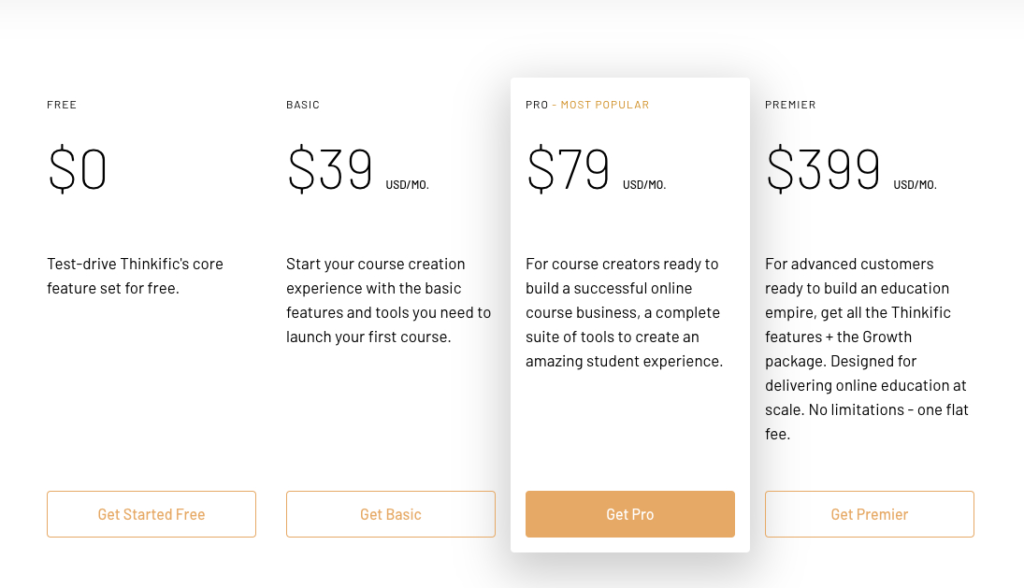
There’s an add-on for the Growth Package, and it’s free for the first 100 students. After that, pricing is based on the number of active students enrolled in your courses. The Growth Package lets you remove Thinkific branding on the course player and website. You can also send bulk emails with it and do advanced segmentation.
Thinkific pros and cons
Pros:
- Thinkific is known for terrific customer service (it’s email only, though)
- There’s a free option to test out the course platform
- Lots of multimedia options
Cons:
- Lacks a native email marketing tool
- The free plan lacks many of the features you would need for a successful course
- Affiliate platform isn’t very robust
3. LearnWorlds
LearnWorlds is one of the more unique Teachable alternatives on this list because you can create really interactive course content. This is a good way to increase student engagement and retention.
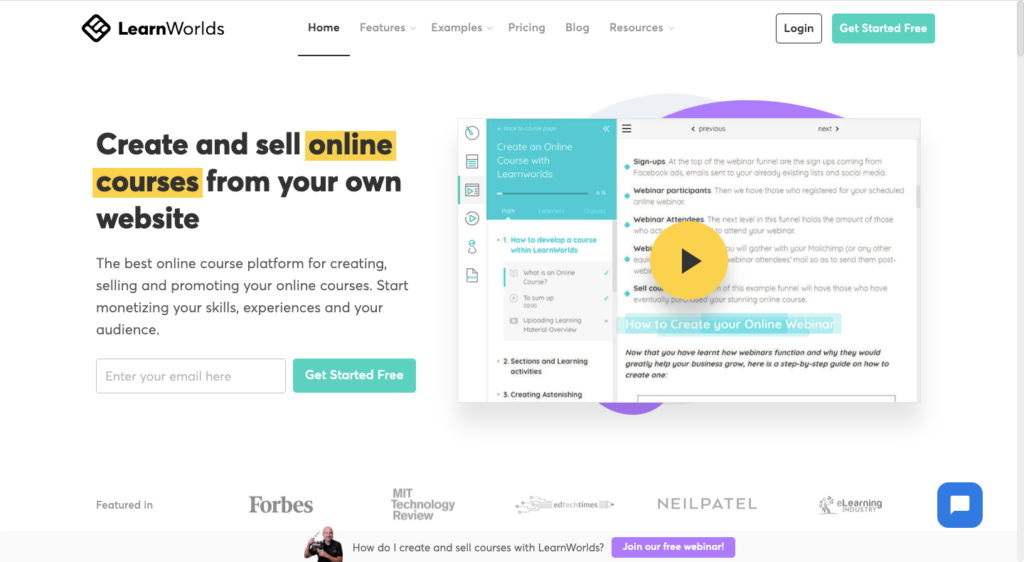
Some of Learnworlds features for interactive online courses include:
- Formal and informal tests
- Note-taking and highlighting capabilities for students
- In-course videos and links
- Drip content or flexible learning pathways
- Synchronized transcripts
- Option to build an integrated social network for your students
Learnworlds has an easy-to-use interface where you can build customizable web pages, landing pages, checkout pages, and branded digital certificates.
All Learnwolds courses and sites have built-in SEO, 5 payment gateway options, accept multiple currencies, unlimited courses, can have conversion pixels for tracking, and have SCORM/HTML5 support. You can keep track of analytics for student progress, events (like failed buying attempts), and you can export user lists.
Learnworlds pricing
There are four options for Learnworlds pricing, and they all come with a 30-day free trial. You’ll need to pony up for the Learning Center plan if you want all of the interactive tools Learnworlds is known for, but it’s $249/month.
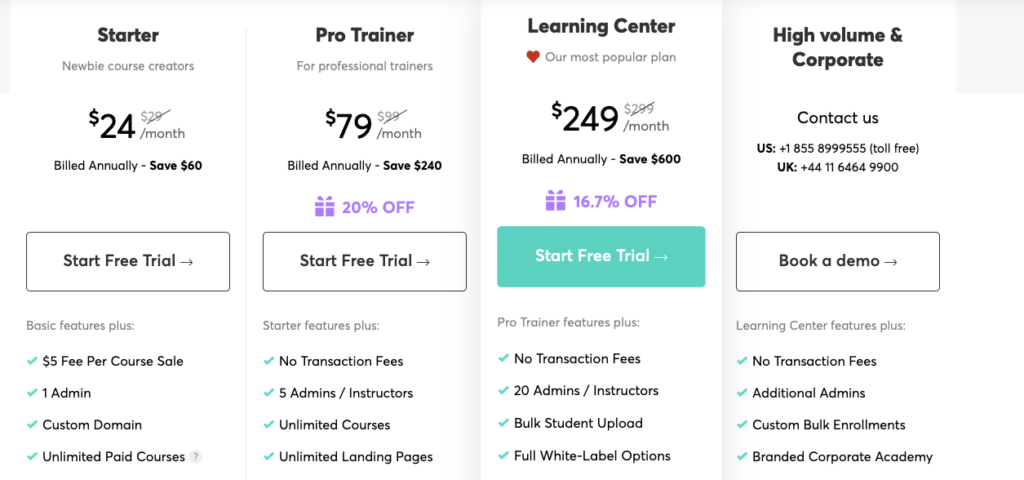
Learnworlds pros and cons
Pros:
- Offers SCORM/HTML5 support
- All options come with a 30-day free trial
- You can create incredibly interactive courses for students
Cons:
- There is a $5/student fee on the lowest priced plan
- No option for bulk content uploading
- No course marketplace
4. Podia
Podia is a platform for creating and selling courses, downloads, webinars, and membership sites. It’s one of the newer Teachable alternatives on this list, but it has robust tools to create your own educational storefront.

Podia has a very clear features list that explains exactly what this platform comes with, and they’re broken down by the steps you’ll go through to open, create, and launch your educational content.
- Step 1 – Features for setting up your store: Free migration, live customer support, iunlimited hosting, multiple languages and currencies, website builder, custom URL, integrations for Google Analytics and Facebook Pixel
- Step 2 – Customize to match your brand: Add image, text, videos, and testimonials; customizable branding; flexible layout; optimized for tablet, mobile, and desktop; and live previews
- Step 3 – Adding products: Easy content migration from other sources, drip content, payment plans, pre-selling options, quizzes, pre-launches, digital downloads (eBooks, PDFs, cheat sheets, checklists, audio files, text, etc.), upselling features, bundled content, membership sites, and paid and free webinars.
- Step 4 – List building and marketing: Email marketing features to help you send newsletters, run drip email campaigns, build funnels, segment lists, and track performance. Plus built-in messaging options for live chat with customers and conversion-optimized checkouts.
- Step 5 – Selling your courses and products: Payment plans, affiliate marketing tools, one-click upsells, coupons, embedded “buy” buttons, product bundles, pre-launch products, and cross-selling tools.
Podia pricing
There are two pricing options for Podia — $39/month and $79/month when you bill annually, and they both come with a 14-day free trial. Both plans are unlimited everything.
The more expensive option comes with additional features like Zoom integration, a blog, affiliate marketing, third-party code, and offsite buy buttons. You can add extra teammates for $20/month per person.
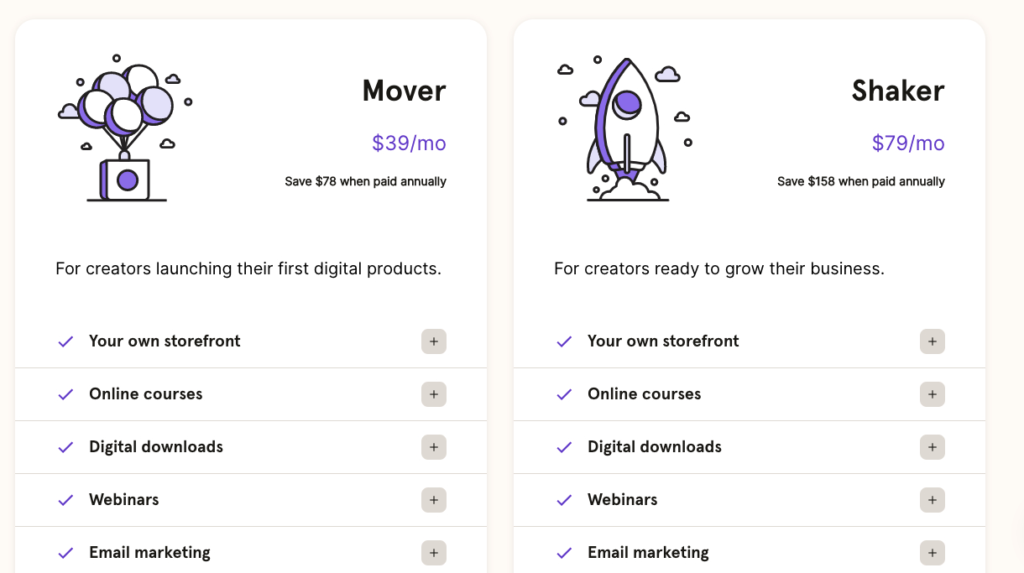
Podia pros and cons
Pros:
- A low-cost option with strong features
- Built-in messaging is unique to Podia
- Very clean looking front and backend design
Cons:
- Even though it has native email marketing tools, they’re not as robust as you’d find with an email service provider like ConvertKit
- Limited design options
- Lacking in advanced features
5. LearnDash
LearnDash is an LMS (learning management system) plug-in for WordPress sites, making it a very different alternative to Teachable. This means you will need a WordPress blog or website to use LearnDash.

LearnDash has a strong course builder, advanced quizzing, drip-feed content, flexible prerequisites, a gradebook, points when a student complete courses (can be used to unlock new lessons), and certificates and badges. LearnDash’s visual course builder shows you how your course flows while you’re creating it.
You can sell your courses by one-time purchases, subscription, or membership sites, and they can be bundled together. Students can be grouped together, you can send email notifications, create user profiles to track student activity, and remove access after a certain amount of time.
All LearnDash courses are mobile compatible, can use any kind of media (videos, Articulate and Adobe captivate files, images, audio, Google docs, and more), and you can use Tin Can API and SCORM.
LearnDash pricing
There are three options on LearnDash starting at $159/month when you opt for annual billing. The real difference in these three options are the number of site licenses you get, from 1 license up to 25 with the Pro Package.
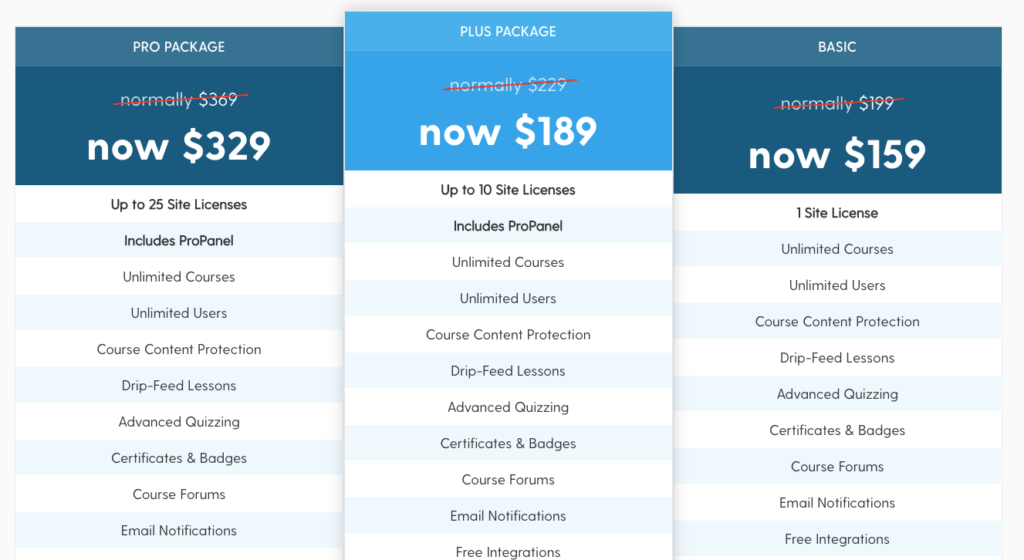
LearnDash pros and cons
Pros:
- Very WordPress friendly
- SCORM compliant
- The visual course builder helps you create a course the connects smoothly from one lesson to the next
Cons:
- Only available for WordPress users
- Fairly expensive considering and doesn’t come with with advanced email marketing tools
- Doesn’t come with a free trial, but there is a 30-day money back guarantee
6. Skillshare
Skillshare is different from the rest of the Teachable alternatives in this list so far. Instead of a course creation tools and features to build your own online schools, Skillshare is a course marketplace only.

Skillshare asks that teachers focus on video-based courses that are 20-60 minutes long total. As the teacher, you are responsible for finding the tools you need to create and edit your lessons — Skillshare has a Teacher’s Handbook to help, and it includes tips for planning and producing classes, what tools you need, how to engage students, etc.
Skillshare pricing
Skillshare is 100% free for teachers. There is no cost to creating and teaching classes on Skillshare. However, you don’t earn anything from your courses until there are at least 25 enrollments. You earn $1-$2/student, and you can earn an additional $10/student for everyone who signs up for a Skillshare membership using your link.
Skillshare pros and cons
Pros:
- It’s completely free for course creators
- Built-in marketing options with the course marketplace
- Because Skillshare courses are inexpensive, you can appeal to many students
Cons:
- Limited earning capabilities
- No built-in features for selling or creating your course
- Easy to get lost in the course marketplace
7. Udemy
Udemy is similar to Skillshare in that it’s an online course marketplace where course creators can teach short, straightforward classes that are easily accessible to all kinds of learners.

Like Skillshare, you’ll have to find outside tools to create your course and then upload them to Udemy’s platform. You can add all of your own branding in the course content, but not on the course page itself.
Udemy courses are organized by topic, and you’ll want to use keywords in your course description to make it easier for students to find your courses. Instructors will need to have their courses approved before they can be added to the marketplace
Udemy pricing
There is no cost to creating courses on Udemy. Instructors earn 50% of each sale that comes through the course marketplace (when users find your course by browsing). You can earn 97% of the course cost when people sign up through your instructor generated course link.
Udemy pros and cons
Pros:
- 100% free option for instructors
- Easy-to-use platform and course marketplace
- Wider student appeal because the courses are very inexpensive
Cons:
- Limited earning potential
- It’s easy to get lost in the course marketplace
- No advanced features for teaching or marketing your courses
The final word on these Teachable alternatives
As you can see, there are lots of alternatives to Teachable — these aren’t even all of them, just the top options.
If you’re looking for one that’s really close to Teachable, then Thinkific, Learnworlds, and Podia will be your best choices. All three of these have similar teaching and marketing tools, plus integrations to connect existing software.
Kajabi is a good pick for those who want a completely all-in-one option, which potential saves you money. The biggest downside to Kajabi is that you’re completely reliant on one platform. So if it crashes, your entire business is down until the issue is fixed.
LearnDash is ideal for WordPress users, but all four of the options above have WordPress plug-ins to make it easy to connect your existing site.
The last two alternatives, Skillshare and Udemy, are really best for those who don’t want a major time or financial commitment. Your earning potential is limited, but these platforms are an easy way to see if you enjoy teaching online courses before making a larger investment.
And don’t think you can’t make money with Skillshare and Udemy — we’ve seen course creators use those platforms only and earn five-figures a month in course revenue. They’ve all built websites and focused on marketing to earn that kind of income.
Whichever platform you go with, creating an online course can be a good source of passive income. It takes work to drive traffic to your courses, Facebook ads are the best option in our opinion, but from there, there’s little work to maintain your courses.
And if you want to create a course but aren’t sure how to get started, check out Learn How to Create an Online Course in Just 9 Steps.


Leave a Reply